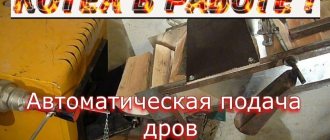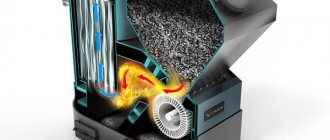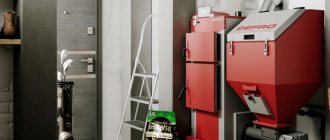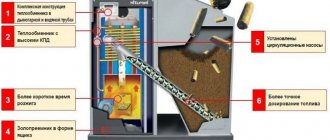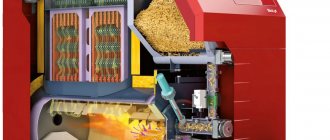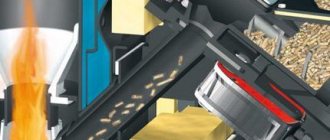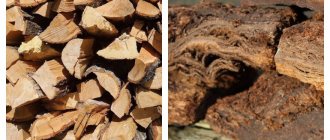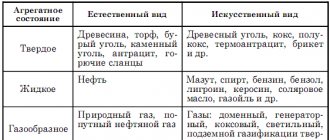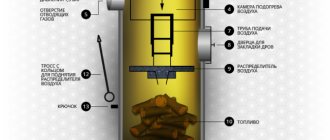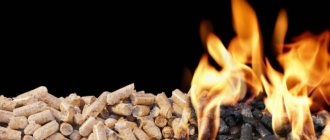If there is no main gas pipeline nearby, then modern pellet heating boilers will be the most effective and economical option for heating residential or non-residential buildings. In addition, such units are characterized by durability, the ability to operate autonomously and safety.
To ensure that the operation of the boiler does not cause trouble, and the purchase does not disappoint, it is necessary to carefully approach the issue of choosing equipment.
We will help you in this matter. The article presents the pros and cons of pellet boilers, indicates the features of their operation and maintenance, and also describes in detail the characteristics and parameters that should be taken into account when purchasing.
Pellets and their effectiveness as solid fuel
Pellets are cylindrical granules compressed under high pressure, obtained by processing waste from agriculture (husks of grain seeds, hay or straw) and wood processing (sawdust, chips, shavings or bark). Peat and coal pellets are less popular.
This is what different types of pellets look like.
The calorific value (specific heat of combustion) of pellets is 17.2–19.5 mJ/kg = 4.7–5.4 kW/h, which is significantly higher than, for example, wood, pure peat and even fuel briquettes . Burning 2 tons of pellets provides the same amount of energy as 960 cubic meters of gas, 1000 liters of diesel fuel or 3.2 tons of firewood.
In Russia, the production of pellets of the “Premium” and “Standard” varieties is permitted, which have an insignificant degree of ash content of 0.4–1% and 1.5–3%, respectively.
Reference . Contrary to popular belief, pellets are produced without the addition of synthetic substances: and although there are standards that allow chemicals in the composition, most pellets do not contain binding substances and improvers, and gluing occurs due to lignin released during heating.
The disadvantages include, perhaps, storage conditions - they cannot be left simply under a canopy, but must be stored in a closed room or container.
How to load fuel correctly
Firebox and chimney
The picture shows an empty firebox. How does the stove work and how to use it?
Unlike, for example, “bubafoni”, the blower pipe is inserted directly into the firebox with the pins down. They should rest against the bottom, with the blower located in the center.
- Fuel loading begins.
- Fuel is loaded up to the chimney level.
- Sawdust must be compacted.
- The better the sawdust is compacted, the more efficiently the stove operates, and this significantly affects the operating time.
- In this case, as the fuel is compacted and loaded, the blower must be slightly rocked to the sides so that a small gap is formed between the blower and the compacted fuel.
- Otherwise, the ignition process will be significantly delayed.
Operating principle of automatic pellet boilers
Hoval pellet boiler in section.
An automatic pellet boiler is a steel or cast iron heating unit, which, from a design point of view, is the same solid fuel boiler, but with the ability to fully automate the work process, i.e. it can function with minimal human intervention.
The principle of operation of a pellet boiler is the sequential interaction of 3 separate systems (a bunker for storing reserves, a mechanism transporting pellets into the combustion chamber and the burner itself), combined into a single device by the ACU attachment - a hardware control unit.
Accordingly, the equipment operation process includes 3 stages:
- Supply of pellets from a bunker or from a fuel storage to the combustion chamber.
- Ignition, achieving the required temperature and maintaining combustion.
- Regular cleaning, including removal of ash and carbon deposits from device elements.
From the storage, the granules are delivered to the boiler bunker.
The dispenser supplies the required amount of granules into the combustion chamber. The pellets ignited by the burner heat the water circuit. In general, automatic pellet boilers designed for domestic use are very easy to maintain. The main thing is to initially correctly set the appropriate operating mode, so that later you can turn the heating on and off with one button and simply monitor the number of pellets.
Pellet feeding system
The organization of an automatic pellet supply system directly depends on many factors (design features of the heat generator model, availability of free space in the room, financial capabilities, as well as other personal preferences) and can be carried out in several ways:
- bulk (spontaneous) - pellets fall into the burner under their own weight, which can only be realized from the built-in hopper;
- pneumatic (vacuum) – supply occurs using a powerful pump that can suck pellets even from another room (up to 30 meters);
- screw (worm) - the intake of granules is realized through a gear-screw mechanism, which involves the portion supply of new batches;
- conveyor (conveyor) – fuel is supplied via a standard (> 45°) or steeply inclined (< 45°) “endless” belt with blades.
An example of organizing the supply of granules using a vacuum method from an outdoor bin.
In addition, for greater ease of installation, the above options can be subject to various modifications and can also be combined with each other.
One load of pellets can be enough for a fairly long period - from 2-4 days to 1-3 months, up to the entire heating season (depending on the volume of the built-in or separate bunker). At this time, the ABU controller itself assesses the situation and ensures uninterrupted operation of the heat generator.
Ignition and combustion maintenance
After pressing the start button, the electric ignition system is activated:
- The glow plug (or heating element) ignites the fuel, and the flame sensor turns on.
- The fan pumps air and creates a stable combustion torch.
- The photo sensor detects the presence of a flame and the glow plug is turned off.
- The boiler switches to heating mode and pellets are regularly supplied to the burner.
- When the temperature reaches 60–70 °C, the maintenance mode is activated.
- The volume of incoming air and the pellet supply speed are reduced.
- When the temperature drops (sharp cold snap), heating begins again.
- The burner will periodically turn on/off in the specified mode.
The fully automated pellet boiler is also equipped with a temperature limiter and a coolant overheating sensor. When the supply of a new batch of fuel to the burner is stopped, the system goes into afterburning mode - the fan burns out the residues for 5–10 minutes at full speed.
Stopping work can be done by manually pressing the “Stop” button or (in case of any error) by a software command from the device. Modern GSM modules make life even easier: they synchronize with mobile gadgets and immediately notify about an emergency shutdown, the end of pellets, etc.
Removing ash and carbon deposits
The frequency of servicing heating equipment, i.e. removing carbon deposits and ash remaining from burning pellets, depends on the degree of its equipment:
- model without automatic cleaning – once every 3–10 days;
- model with self-cleaning function – once every 4–6 weeks
That is, the built-in self-cleaning system does not completely eliminate the need for manual cleaning, but only allows you to significantly reduce its frequency.
Boiler unit with automatic cleaning system.
Automatic ash removal occurs through the transportation of burnt-out residues into a voluminous outer container using a screw conveyor. When stirred, the ash is compacted, which saves space in the ash pan. The drive of this mechanism can operate either from the controller of the boiler itself or autonomously.
Automatic removal of carbon deposits from the burner is carried out using knives - moving parts of the grate. In fact, they simply cut off the charred resin particles and direct them to the ash bin. When it is full, the consumer is given a signal about the need to clean it.
What you need to know about pellets?
Wood pellets used as fuel come in different sizes depending on the standards adopted by the state. Thus, pellets produced in the European Union reach a length of 30-60 mm. In Russia, where the rules have not yet been established, the granules may be longer.
Therefore, if you use such a product for a boiler manufactured in Europe, it will be difficult to configure the automation to the desired mode. As a result, overexpenditure, incorrect operation in modes specified by the owner, etc. are possible.
The bunker can be located at a significant distance (up to 10 m) from the boiler itself
Also, all heating boilers operating on pellets require that they be of sufficient quality. That is, the granules must retain their shape until they enter the firebox. Otherwise, overspending is inevitable.
The strength of pellets depends on the quality of production and humidity. It is important that it does not exceed 12%. If the norm is not observed, the calorific value will decrease, and in severe cases the granules will become completely unusable.
This type of fuel is:
- household (ash content up to 1%) - they are made from hardwood waste with minimal addition of bark;
- industrial (ash content up to 3%) - it is made from coniferous waste with the addition of bark (up to 10%);
- from agricultural waste (ash content more than 3%) - they are made from biomass of various origins (sunflower husks, straw).
Granules for household use are characterized by the highest calorific value, as they contain a small amount of dust and have low humidity. They are always white.
Cheaper ones are granules for industrial use. Low cost is their significant advantage. Their disadvantage is not the highest calorific value. In addition, the boiler will have to be cleaned much more often and this procedure will be more labor-intensive.
Industrial granules can be identified by color - they are dark brown. They are undesirable for domestic use due to their low calorific value.
There is another type of pellets made from agricultural waste. But you shouldn’t use them - they have extremely low calorific value and high ash content. This means that the boiler will become clogged often, and in this case it is quite difficult to clean it, especially with frozen ash.
You can set up the production of pellets yourself; more details about the manufacture of a special press are written in this article.
Reviews of household automatic pellet boilers: advantages and disadvantages
Reviews from owners of automatic pellet boilers indicate that this technique has both strengths and weaknesses, or rather, nuances:
| Advantages | Flaws |
| autonomy – equipment with a GSM module can remain unattended for weeks | cost – the price of even the most modest options is 100–120 thousand rubles. |
| versatility - work on wood chips, husks and sawdust | energy dependence , a backup generator is needed for operation |
| Convenience – self-cleaning and auto-feeding minimize manual maintenance | service - many foreign companies simply do not have a representative office in Russia |
| safety – the body does not heat up, which is especially important for children and animals | granule consumption - often real figures differ from theoretical calculations |
| cleanliness - there are no traces of use in the room, i.e. soot, dust and smoke | fuel price - the cost of pellets exceeds the cost of firewood or coal |
Reference . An unexpected increase in pellet consumption is often associated with inadequate quality of the product itself: if they contain foreign impurities or their moisture content is more than 10–12%, then in order to maintain a given regime it becomes necessary to compensate for the loss of heat capacity in quantity.
Safety of combi boilers
During operation of the heat generator, the following emergency situations are possible:
- reverse draft with fire escaping into the bunker and igniting the entire supply of fuel pellets;
- when operating on wood, the working medium boils;
- clogging of the chimney and, as a result, the entry of carbon monoxide into the room.
During operation of the boiler, emergency situations are possible.
The following types of fire protection are used:
- A plastic corrugated pipe installed between the auger and the pellet burner. During reverse draft, it melts, as a result of which a gap that is insurmountable for fire is formed between the unit and the bunker.
- 2-screw feeding system. Its design provides for an air gap in the transport channel.
In case the coolant boils near the boiler outlet pipe (no further than 0.5 m), install the so-called. a security group consisting of the following devices:
- air vent;
- safety valve;
- pressure gauge.
It is prohibited to place shut-off valves in the area between the heater and the appliances.
To discharge excess energy, the piping is supplemented with an emergency radiator or heat accumulator. There are models with a cooling coil in the boiler tank connected to the water supply.
The draft in the chimney is controlled using a temperature sensor. If it detects that hot exhaust has stopped flowing into the pipe, the fuel supply is immediately stopped.
What to look for when choosing a boiler unit
The efficiency factor (efficiency) is the most important point that is worth paying attention to, since it is it that shows the efficiency of the heating device. Manufacturers usually indicate an efficiency of 85–98%, but in reality it depends on the correct settings, the quality of the granules and design features.
Main characteristics of automatic pellet boilers:
| Burner type | |
| retort (meat grinder) - “omnivorous” vertical burner, but the use of less heat-intensive fuel reduces efficiency | stoker (flare) – horizontally directed burner, efficient, but demanding on fuel quality |
| Heat exchanger material | |
| steel is durable, but (with a thickness of up to 6–8 mm) material subject to burning | cast iron is a durable, but fragile material if used improperly |
| Control system | |
| built-in controller - a control unit located on the boiler controls the processes of loading granules and heating | full automation - options for feeding, ignition, heating, self-cleaning, thermal and photosensor, timer and protection system |
| Maximum power | |
| The boiler power required for heating a house is calculated individually, but in any case it is recommended to buy the device with a small margin of 10–20% | |
| Heating circuit | |
| single-circuit - intended only for heating the space of the house itself | double-circuit – allows you to heat water for sanitary and domestic needs |
Reference . If there are several heating systems, such as radiators, water supply and heated floors, or it is necessary to create climatic zones, then it is better to purchase dual-circuit equipment with additional automation that allows you to control several temperature conditions at the same time.
It is also worth paying attention to equipping the boiler with a device for swirling fuel gases: thanks to it, part of the heat does not go into the chimney, but is transferred as much as possible to the heating system, which increases efficiency, and also prevents ash formation, because The pellets burn out almost completely.
How to choose a room thermostat for a heating boiler and save up to 30% every month
Unit design
The pellet boiler itself consists of three main components:
- Furnace - equipped with a special burner (retort or torch) and two doors (control, cleaning).
- Convective zone - a heat exchanger is located in it: it can be vertical, horizontal or combined, tubular or plate type. In the convective zone, the coolant in the heat exchanger is heated by gases released during the combustion of pellets. Most units are designed only for heating and have one circuit, but some models have two circuits: heating and water heating.
- Ash pan - it receives combustion waste (insignificant during normal afterburning), which is periodically removed through the cleaning door.
However, the listed components are, although the main part, but only a part, the operation of which requires the APT attachment (automatic fuel supply). This attachment includes the following components:
- A hopper is a container for pellets of a certain volume, from which the pellets enter the combustion chamber; it can be built-in or external.
- Auger - portions feed granules to the burner as needed, driven by a gearbox.
- A fan is necessary to maintain the combustion process, since the boiler design does not provide for natural draft.
Since the pellet boiler is an automated system, its device also includes a control unit with a display, which displays information about the current state, and through which the main operating parameters are set. The controller regulates the ignition of the burner, the supply of pellets and air, and stops when the desired temperature is reached, maintaining the heating mode selected by the owner.
Depending on the capacity of the bunker and the selected mode, one filling can be enough for several days, a week or even more.
To make the heating process fully automatic, the boiler can be connected directly to the storage - a pneumatic pipe will supply granules to the bunker as it is emptied.
The best known manufacturers and models: characteristics and prices
When choosing a pellet boiler with automatic feeding, you need to focus not only on the technical characteristics, but also on the manufacturer, since not everyone will be able to ensure timely delivery of replacement parts, as well as provide a specialist for installation, configuration and warranty service.
Therefore, in order not to be left without heating at the wrong moment, it is better to choose a proven model from a company with extensive experience in this field.
ZOTA Pellet-15S
Wear-resistant pellet boiler made in Russia, supporting different types of fuel (pellets, firewood, briquettes). It is designed taking into account operation in harsh winter conditions that imported solid fuel boilers cannot withstand.
Those. parameters : power – 15 kW, bunker volume – 296 l, efficiency – 90%.
Average cost : 150,000–170,000 rubles with standard equipment.
Manufacturer : TPK KrasnoyarskEnergoKomplekt, Russia.
FACI 15
A compact boiler with a twin-screw feeding system ensures high combustion efficiency of almost any crushed biofuel. It is equipped with a retort cast iron burner of the “anti-slag” type, which allows you to reduce the ash content of even low-quality pellets.
Those. parameters : power – 15 kW, bunker volume – 352 l, efficiency – 92%.
Average cost : 130,000–150,000 rubles with standard equipment.
Manufacturer : FACI-RUS LLC (FACI Caldaie), Russia-Italy.
Teplodar Kupper OK-9 with APG 25 burner
A universal boiler equipped with an APG 25 pellet burner is also suitable for conventional solid fuels, including wood and coal. The simple combined design is easy to modify; if desired, you can switch to a gas burner.
Those. parameters : power – 9 kW, bunker volume – 200 l, efficiency – 68–95%.
Average cost : 80,000–110,000 rubles including a torch burner.
Manufacturer : Teplodar LLC, Russia.
Biopellet P-15
A boiler with an original but well-thought-out design, which is easy to assemble and maintain even by an untrained specialist. It is unpretentious to the quality of pellets; you can burn both white and gray varieties without the risk of the burner stopping due to contamination.
Those. parameters : power – 15 kW, bunker volume – 200 l, efficiency – 92%.
Average cost : 160,000–180,000 rubles with standard equipment.
Manufacturer : Dozatech LLC, Russia.
START-50-GR
A powerful, domestically assembled boiler with an impressively sized hopper and imported components (automation and burner). Known for its high reliability and durability, thanks to cast iron parts (burner, boiler door, grates) and a durable heat exchanger made of 6 mm thick steel.
Those. parameters : power – 50 kW, bunker volume – 400 l, efficiency – 95%.
Average cost : 230,000–250,000 rubles with standard equipment.
Manufacturer : LLC Heating boilers "START", Russia.
How to choose the right equipment
Even before deciding to purchase a pellet boiler, you should understand a number of points in order to avoid significant financial losses. It so happens that, in a hurry with the purchase, the owner cannot install the purchased equipment or fully operate it.
What to look for before buying
So, before buying, you should understand several nuances.
First , make sure whether it is possible to place the necessary equipment in the building. Usually it is installed on the ground floor, in the basement.
It is necessary to take into account not just the expected dimensions of a particular product, but also the requirements for its installation, for example, there must be gaps of 700 mm or more between the components of the boiler.
Secondly , you need to figure out whether it is possible to store fuel in the required quantity. It is also necessary to pay attention to the convenience of its delivery to the boiler (delivery from the supplier, movement from the storage location to the bunker). And fuel should only be stored in a dry room.
It should be kept in mind that there will be quite a lot of pellets. For example, to heat a house with a relatively small area (100 sq. m), when it is cold, you will need 25 kg of pellets per day
Thirdly , is the power of the electrical network sufficient? Since the control unit, together with the sensors, and the ignition system are powered by electricity, for normal operation, for a short period, they can create a significant load.
This happens during the boiler ignition procedure, when a special heating element raises the temperature in the combustion chamber to an impressive 1000°C so that the pellets ignite.
The line of boilers from the Teplodar company includes combined boilers COOPER PRO, which can be used as both solid fuel and pellet:
Image gallery
Photo from
COOPER PRO 42 with pellet burner APG 42
Boiler processing of wood and coal
Water tube heat exchanger
Automation for organizing boiler operation
Take care of fuel in advance
Also, before purchasing a boiler, you should find out whether there are organizations nearby that supply pellets. There should be several sellers - if there is only one and suddenly ceases to exist, then problems with operation will begin.
It is also necessary to pay attention to the fact that it is usually cheaper to buy fuel from the manufacturer. To prevent any accidents, a potential buyer of pellets should familiarize themselves with the sellers' offers before purchasing.
It is advisable to contact them directly and find out all the details - delivery costs, whether the organization will be able to deliver regularly, etc. And for industrial expenses, it is best to sign a supply agreement with the supplier before purchasing.
The bunker can be installed on any side of the boiler - the main thing is that it is convenient to use the equipment
Rules for choosing a pellet boiler
If there are no doubts about the possibility of installation and the provision of fuel, then you can proceed to choosing a boiler. This should be done by calculating the power.
Theoretically, it is not difficult to calculate - all manufacturers indicate this characteristic in their data sheets, and for simplicity they add how many square meters the boiler is ready to heat.
For example, if the description says that the power is 30 kW, then the manufacturer will indicate that his boiler is capable of heating 200-300 square meters. m of premises. But all these are average values, which are of little use for determining exact values.
Also, any person can perform the calculation himself, since it is believed that 1 kW of power is needed for every square meter. The formula is relevant only for buildings with insignificant heat loss. Effective heat-insulating materials were used in their decoration, and the doors and windows also matched them.
Otherwise, it is necessary to calculate heat loss, which only a specialist can do. This will cost money, but it will guarantee that the building will be warm and you won’t have to overpay for it.
Without the necessary calculations, the purchase will be made at random, which is unacceptable, given the cost of purchase and installation
In addition to the rated power, it is worth considering such a moment as its modulation. Although it sounds incomprehensible, everything is simple here - this is the ability of a pellet boiler to operate at conditions below its maximum productivity.
This is true for regions where temperatures are not the coldest for most of the season. Therefore, heating equipment does not need to operate at full capacity, but rather use only 30-40% of it.
If the boiler does not have such an opportunity, then, at first glance, this is not a problem - having reached the highest temperature specified by the user, it will turn off. When it drops to the minimum set level, it will turn on again. But during such switching on/off wear occurs, which significantly reduces the service life of the equipment.
Heat exchangers are made of steel or cast iron. The former give off heat better, are less massive, the latter are more resistant to corrosion
You should also pay attention to dynamic power. The owner may encounter this characteristic rarely, but in unpleasant moments (if the boiler is chosen incorrectly).
To understand dynamic power, it is enough to look at an example: there was a sharp drop in temperature and the boiler began to not cope with heating.
If it has enough opportunities to briefly, but significantly, increase its productivity and quickly bring the temperature to the set point, then the boiler has sufficient dynamic power. If this does not happen, then the specified characteristic is insufficient and it is better not to buy a boiler - it will sometimes make the owners freeze.
How to choose the right equipment model
When the power is determined, you can proceed to choosing a model. At this point, the potential buyer will understand that there are many manufacturers, as well as models. In order not to get confused in this variety, you should decide which boiler to buy from a well-known domestic or foreign manufacturer.
You should only buy equipment from a well-known seller in the country or region who provides service, updates of all software, and repairs of the sold boiler.
The larger the bunker, the greater the autonomy of the equipment. This will allow you to avoid adding fuel longer.
Also, when choosing, you should pay attention to the type of model you like, advantages, versatility, etc.
But in any case you need to check:
- is the boiler certified by Rostechnadzor;
- are there conclusions from independent specialized institutes confirming the high efficiency of the selected equipment and the amount of harmful emissions;
- is there a fire extinguishing system and can the boiler automation prevent a “backfire” when for some reason the flame begins to move from the burner to the hopper;
- what methods are used to prevent overheating of a working boiler.
Since the boiler will operate in different modes, it is worth checking information about efficiency and emissions in all of them. It would also be a good idea to check the noise level and worry about safety.
In addition, you should look at how easily the equipment is programmed, controlled, and whether it has automatic ignition so that all household members can handle it. Cleaning the product from ash should also be simple.
Since the boiler will be connected to other heating equipment, you always need to find out the standards, connection diagram, manufacturer’s requirements in this case, and pipe diameter. The last point is especially relevant if they are already installed or purchased.
Calculation of the minimum required power
The simplest way to calculate the required boiler power ( N ) is using the formula:
N =S×W beats /10
- , where S is the heated area of the house, taking into account all residential and domestic premises;
- W beat – power required to heat 10 m2 (according to the climate).
In central Russia, a moderately insulated room with a ceiling height of 2.5–2.7 m and an area of 10 m2 can be fully heated with a power of 1.1 kW.
Thus, the minimum required power of a pellet boiler for heating a house of 10x15 m will be calculated using the formula 150 m2x1.1 kW/10=16.5 kW.
Selection options
Manufacturers produce a large number of different models of pellet boilers. You can buy them in specialized or online stores.
When choosing the optimal model for yourself, you need to pay attention to factors such as:
- unit power;
- efficiency;
- functionality;
- fuel consumption;
- number of circuits.
Double-circuit boilers can be connected to heating and hot water systems. When choosing a pellet stove, be sure to take into account what type of room it will heat: residential or industrial. For domestic needs, a small power boiler is sufficient.
Installation standards and requirements
Installation of long-burning boilers with automatic loading of pellets is carried out taking into account existing fire safety rules (FSR):
- placement in a separate room - boiler room (basement or annex);
- covering the floor in the room with the boiler exclusively from non-flammable material;
- a room without high humidity, equipped with a ventilation system;
- the minimum distance from the boiler to the pellet storage place is at least 1 m;
- fireproof partition between the external fuel storage and the boiler;
- organization of the chimney in accordance with the building codes SP and SNiP.
Despite the fact that before installing a pellet boiler you do not need to contact any regulatory authorities (for approval and examination), as practice shows, it is quite difficult to independently install and connect weather-sensitive equipment, so it is better to entrust these matters to professionals.
Combined (with several combustion chambers)
If you need to use two completely different types of fuel (for example, pellets and coal), you should consider models with multiple fireboxes.
They have their drawbacks:
- they are more expensive than usual;
- they are more bulky;
- loading coal into a small boiler is difficult to automate - you will have to load it with a shovel; in this case, the person actually turns into a fireman and is forced to frequently load coal into the boiler;
- When coal burns, a lot of soot is formed - the boiler walls and smoke channels will have to be cleaned frequently, otherwise the efficiency of the boiler will decrease;
- after coal combustion, a lot of ash is formed - it must be removed and then disposed of;
- more space is required for fuel storage - coal is usually purchased by machine.
Design and principle of operation
The design of a firebox for pellets is absolutely identical and no different from the firebox of a boiler for one type of fuel. The coal combustion chamber is larger, it holds a large amount of coal - so that it can be heated all day long; and is adapted for manual loading of fuel. The unit is larger and requires more space for installation. This boiler has no other features.
The operating principle of a pellet firebox is no different from the operating principle of a specialized unit’s firebox. The coal furnace operates according to the same scheme, but there is no automation of fuel loading.
Coal-pellet boiler
How much fuel will you need for the heating season?
Pellet consumption ( Mx of time is calculated using the formula:
M x =X/ fuel heat capacity
, where X is heat loss during the heating season, determined by the formula:
X = S×D×24×0.9×70
- , where S is the heated area of the house, taking into account all residential and domestic premises;
- D – duration of the heating season;
- 24 – number of boiler operating hours per day;
- 0.7 – boiler operating coefficient;
- 70 – average heat loss per hour (for a typical residential building).
For the calculation, you can take a house of 150 m2 from the previous example. If you heat it for about 6 months (175 days) a year, then the heat loss will be X = 150 × 175 × 24 × 0.7 × 70 = 30870 kW for the entire season or 177 kW per day. Accordingly, the consumption of pellets for the same period will be equal to M1=30870/5=6174 kg (season) and M2=177/5=36 kg (day).
Heating costs per month are calculated by multiplying the average daily consumption of pellets by the number of days and the price of pellets per 1 kg, i.e. 36×30×8.5=9180 rubles.
Consumption of pellets for heating a house
Pellet consumption depends on factors such as:
- Calorific value of pellets
- Room volume
- Maintained temperature
- Heat loss
- Duration of the heating season
You can calculate the annual consumption of a pellet boiler for heating your home using our online calculator:
Price
Cost of pellet boilers with automatic fuel supply:
| Model name | power, kWt | Average price, rub. |
| ZOTA Pellet-15 S | 15 | 153 000 |
| FACI 15 | 15 | 146 000 |
| Cooper OK-9 + APG 25 | 9 | 101 000 |
| Biopellet P-15 | 15 | 171 000 |
| START-50-GR | 50 | 242 000 |
| ACV ECO Comfort 25 | 25 | 217 000 |
| Kiturami KRP-20 A | 30 | 236 000 |
Classification
Most models of pellet boilers are intended only for heating buildings, but there are designs that can also provide hot water. The units produced by manufacturers are classified according to various criteria.
Boilers are classified according to the method of fuel supply:
- automatic;
- semi-automatic;
- mechanical.
Automated models work according to a given program. When servicing semi-automatic boilers, you have to perform some functions manually. Mechanical units are fully human-serviced.
Where to buy a pellet boiler with automatic feed?
In Moscow
- Hermes , st. Bulatnikovskaya 20, off. 17 from 9:00 to 18:00, tel. +7(495)384–19–66;
- Stoves -Fireplaces , st. Yubileinaya 4-A from 9:00 to 18:00, tel. +7(495)215–56–94.
In St. Petersburg
- TechnoDom , Stachek Ave. 57 from 10:00 to 19:00, tel. +7(812)671–00–88;
- TeploTorg , st. Yakornaya 10 from 9:30 to 18:00, tel. +7(812)612–40–02.
And in conclusion: an automatic pellet boiler, despite the fact that it is, of course, easier to maintain than many other options (for example, coal, wood, pyrolysis), still requires attention - both in terms of cleaning and in terms of purchased fuel. These factors should be considered before purchasing.
Pellet boilersAutomatic feedSolid fuel boilers
Starting and maintaining the boiler
Before the first launch of the structure, you will need to invite a specialist to check all elements for compliance with safety requirements. It is not recommended to switch it on yourself.
Start-up is carried out only after checking the unit for compliance with the selected scheme. The tightness of the chimney, bunker and the boiler itself must be checked. Before starting, you need to make sure that the heating system is full and the pressure in it corresponds to parameters suitable for operation. All instruments and automation must be in working order.
Caring for the unit is not difficult. As it burns out, it is necessary to add fuel, clean the stove from ash, and also monitor the performance of the automation elements. Separately, you will need to check how the burner and ignition system work.
Sawdust boiler cost
Scheme of operation of a solid fuel boiler.
Heating with sawdust is quite profitable. It is necessary to clarify that the design itself usually has a decent cost, but during operation it justifies itself. After all, you can heat your apartment with any waste; a long-burning boiler will process everything. You don’t have to constantly search for fuel; it is consumed very economically. Such a boiler can warm the space around it for about a week, depending on how much raw material is put into it. Of course, the most profitable thing would be not to buy it in a store, but to make it yourself.
If we talk about how long a long-burning furnace can operate, we cannot fail to mention the Popov boiler. It has a very high efficiency, as it is capable of generating 1 kW of energy per hour from 100 g of sawdust. That's a pretty decent amount of heat. In practice, this figure causes a lot of controversy. Some owners of such heating devices confidently state that they are not capable of producing more than 500 W per hour. Whether this statement is true or not, a long-burning boiler is very expensive on the market. How to make a long-burning boiler with your own hands? Now no one doubts that it is very profitable to use sawdust on the farm. Making it yourself is not as difficult as it seems. Although it is necessary to have a good understanding of the principles of its operation. The raw materials that enter the oven must be well compacted; they are laid in several layers. The more firmly it is compacted, the better, thereby increasing the efficiency of the device. After all, even an ordinary stove can show good results if you use carefully dried firewood (but it will take at least 2 years to dry). This is too labor-intensive a process, which is why no one does it.
The simplest homemade sawdust boiler may outwardly resemble the familiar potbelly stove. But such a stove will be able to work for a good half of the day with only one refill. A similar design can be used not only for heating, but also for smoking meat or fish.
Before starting work, you need to prepare all the materials:
Diagram of a long-burning boiler.
- raw material tank;
- steel sheets 2-3 mm thick;
- steel sheets 4-5 mm thick;
- welding machine;
- Bulgarian;
- brick;
- cement mortar;
- rectangular pipes with a profile 60x40 mm;
- round pipes with a diameter of 40 and 50 mm.
The first step is to make 2 cylinders from steel sheets. The diameter of one cylinder should be slightly larger than that of the second. The smaller cylinder will need to be inserted into the larger one and a lid attached on top. You can also make the lid yourself from the same steel. The bottom must be welded from below. The thickness of the bottom and lid should be twice that of the walls of the tank (approximately 5 mm).
The pipes need to be selected so that they fit perfectly into each other: then it will be easier to assemble the structure. The rectangular pipes will be in a vertical position, and all the others should fit into them. Therefore, holes of the appropriate diameter must be made in rectangular pipes. 2 pipes must be connected to the boiler. One for hot water output, and the second for cold treatment. Therefore, holes with a diameter of 5 mm are also made in the walls of the boiler.
Now you can start welding the pipes. This must be done very carefully so that there are no gaps left. Water pipes should be welded last. The open ends of the pipes are thoroughly welded with small pieces of steel.
A homemade sawdust boiler should not allow water or smoke to pass through. Therefore, it must be checked for leaks. This is easy to do with ordinary water. It just needs to be poured into the pipes. If a leak is found, the holes will need to be sealed.
Now that the entire structure is fully assembled, it will need to be mounted into the furnace frame. This frame may look like a regular box. To assemble it, you will need bricks and cement mortar. It is best to assemble such a frame in advance, and not at the last moment.
Recommendations for making a boiler
The first thing to do is choose the design of the unit. Here the recommendations are as follows: do not complicate your work and choose the boiler design taking into account the future. In simple words, it is worth separating those elements that you can make yourself from others that you will have to purchase. The latter includes a burner device with a set of automation.
Some craftsmen suggest making a burner with their own hands, but this unit is quite complicated, you can spend a lot of time and effort on it, and as a result, the functioning and consumption of the pellet boiler will be unpredictable. It’s probably easier to buy a finished product and put it in a homemade unit, but everyone decides this question for themselves.
To choose a design that takes into account the perspective, you need to make it universal. That is, it is proposed to make a homemade pellet boiler in the image of a conventional solid fuel unit, in which it is possible to burn wood and coal. In essence, the heat exchange processes occurring in both types of heaters are identical, only the fuel and the method of burning it differ, as shown in the figure:
So, we boldly accept the design of a traditional solid fuel boiler with the possibility of embedding a burner device on a mounting plate instead of the loading door. This will provide the following benefits:
- Since the production of pellets is not yet very widespread in our country and there may be interruptions in the fuel supply, you can remove the pellet burner at any time and heat your home using wood or coal.
- It will be possible to use natural gas or diesel fuel by installing a gas or diesel burner instead of a pellet burner.
To fire the boiler, it is best to use heat-resistant steel 5 mm thick. The ideal option is steel alloyed with chromium and molybdenum (stainless steel), but it is quite expensive, and special skills are required to weld it. For this reason, pellet boilers are made of ordinary carbon steel St20, and for the casing of the water jacket, grade St3 with a thickness of 3 mm is suitable. It is preferable to take blanks for doors and flame tubes for the heat exchanger from the same metal as the combustion chamber. The grate is cut out of steel 10 mm thick or simply purchased ready-made. Well, for the chimney and coolant pipes you will need pipe sections of appropriate diameters.
Assembly is carried out by welding, using the drawings of the pellet boiler. Particular attention should be paid to strengthening the walls of the water jacket with pieces of steel strip or angle, as well as the removable design of the loading door. Upon completion, the welds must be tested for permeability and defects must be eliminated.
Features of pellet stoves from
belongs to domestic manufacturers and produces units whose power ranges from 16 to 170 kW. The level of automation of this product is in no way inferior to foreign analogues. Let's look at the main functions of boilers from:
- automatic delivery of granulated raw materials to the fuel compartment;
- auto ignition;
- self-cleaning.
The unit is controlled by a special controller, which is equipped with a touch screen. And also in the basic configuration, this product has a weather-compensating control system. Loading of pellets into the fuel compartment is carried out using pneumatic feed.
Diagram of a Svetlobor boiler with a pellet pneumatic loading system
Automatic ignition mechanism
In operating mode, the turn-on interval of a correctly configured boiler allows you to take advantage of the residual fire from the coals of pellets that have not yet burned. But during initial startup or non-optimal settings, the automatic ignition system comes into operation. This part represents a high-temperature hair dryer
in a fail-safe housing.
When it starts, the amount of energy consumed increases sharply (150-200 kW/hour) compared to normal operation (up to 0.5 kW/hour). This system is included as standard in most models. But it can be installed additionally. Most manufacturers produce such hair dryers for separate sale, but with 2-3 times more power. This is explained by the need for a higher temperature for ignition if the hair dryer is installed in a place that is not optimal for its functioning.
Arson using a ceramic or metal incandescent heating element. It is installed mainly in retort burners at the lower level of pellet combustion. Some models use the electrode method, but it is very sensitive to the moisture content of the fuel pellets.
Pellet feeding mechanism
Screw feed.
The most common and reliable, but not the ideal type. Although the use of a rigid auger guarantees the flow of fuel into the boiler, with a length of more than 2 m, most of the granules are ground into dust. If the hopper is distant from the boiler or the supply hole is not at the same level as the burner, the supply design becomes significantly more complicated. Another auger for feeding pellets directly into the boiler, a transfer chamber, an electric motor interface module, and a fire protection system against reverse draft are required. Chain feed can be used for pre-delivery. With this type, the granules are not damaged, but a lot of noise is produced. Flexible screws with polymer feed pipes are a more unpretentious, albeit less reliable system. The distance to the hopper can be increased to 12 m. The pipe can be bent up to 45 m. Among the shortcomings, one can notice a more complex and thorough system for fixing the supply pipe.
Pneumatic supply.
When using flexible hoses, the range to the storage bin increases to 80 m, but this method requires a powerful compressor. New developments involve the use of a special vacuum transition chamber, which helps reduce the required pump power. A screw feed is used to directly deliver pellets to the combustion chamber.
Boilers from Wirbel - versatility and ease of installation
The Wirbel company is located in Austria and produces automatic pellet boilers. The products of this manufacturer are of high quality and easy to install. Wirbel EKO-CK PELLET-SET stoves are universal and include an integrated pellet burner.
Raw materials are supplied to the firebox of Wirbel pellet boilers automatically, so it can operate continuously as long as there is a need to heat the room
The body of such a unit is made of heat-resistant steel, the thickness of which is 5 mm. The container for fuel pellets can be installed on either side of the boiler. The standard equipment of the stove includes the following functions: automatic ignition, supply of pellets to the combustion chamber. However, if necessary, the unit can also operate in manual mode.
The operation of the solid fuel heating device is controlled through a special remote control. Cleaning of Wirbel EKO-CK PELLET-SET models is a necessary measure and is carried out at least once a week.
Quality control
Before loading and igniting the unit, it is necessary to check the tightness of the water jacket and check the quality of the welded joints. This will require an air compressor. You can test seams in two ways, which are very reliable:
- Hydraulic. The entire container is filled with water, a compressor is hermetically connected to the fitting, which should create an excess pressure of 2-3 bar. Water does not have the property of being compressed, so it will flow through all uncooked places.
- Pneumatic. Pressure is created without water, and all welds are coated with soap foam using a brush. The bubbles will show where air is leaking through. During the test, the pressure drop can be monitored using a pressure gauge on the compressor.
There is such a type of solid fuel heating source as a sawdust mine boiler. Its design and operating principle are different and more complex, although it is also quite possible to make it on your own. It works due to the fact that sawdust is burned in the lower part of the unit, pouring there from the bunker, this can be seen in the figure.
The process continues in smoke pipes, which intensively heat the coolant. The principle of afterburning wood gases (pyrolysis) is used. Operation efficiency is increased by installing an air blower - a blower fan. Making a boiler using sawdust and tyrsa with your own hands is not so difficult in practice, but it will definitely give a noticeable economic effect both during production and during further operation.
